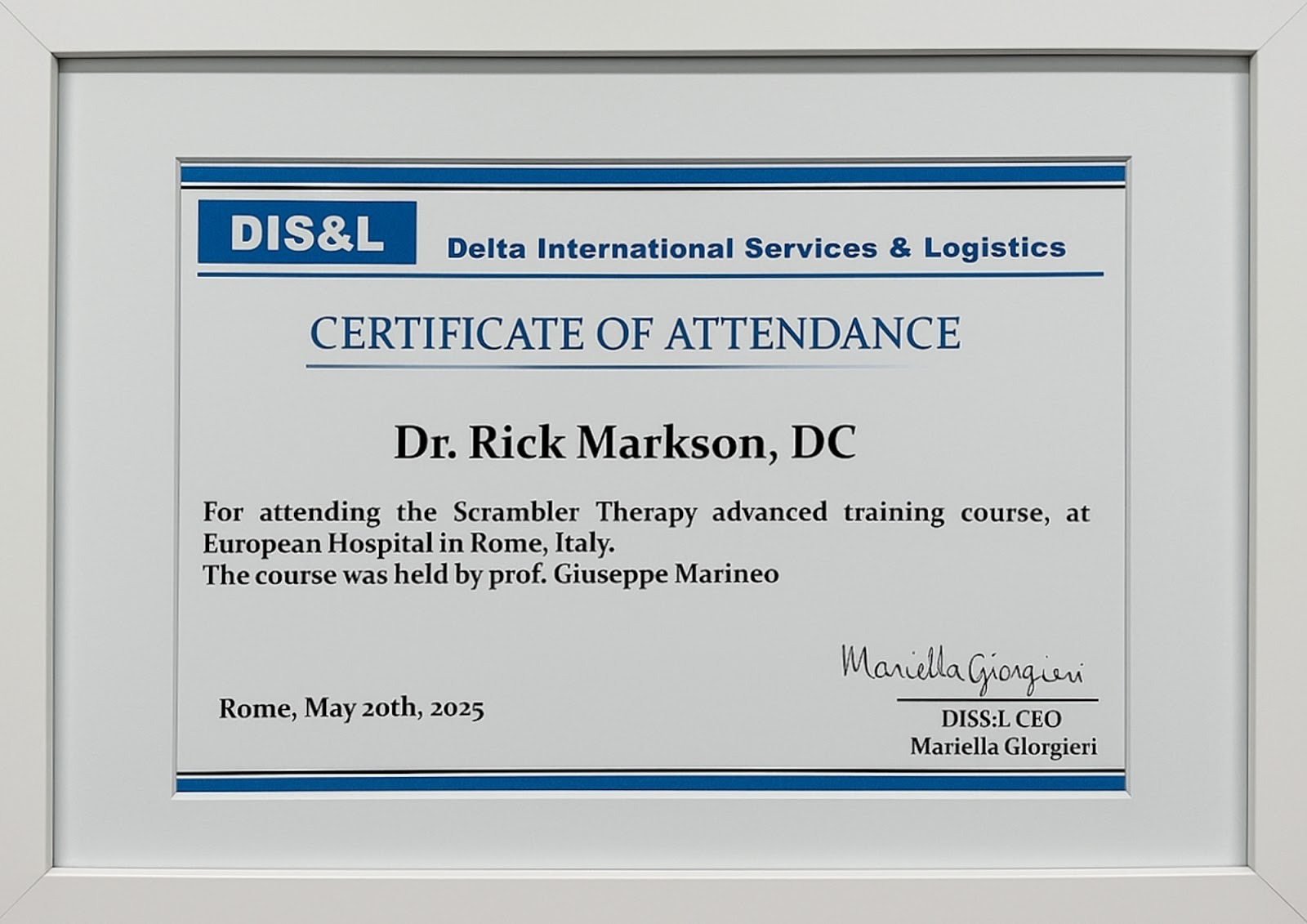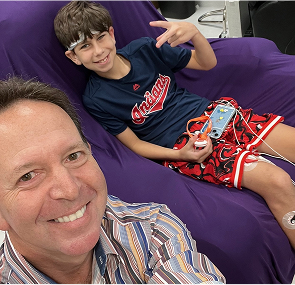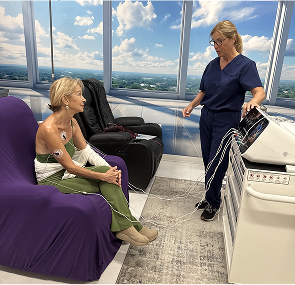History of Scrambler Therapy & Its Development

Chronic pain triggered the invention of Scrambler Therapy. Before the 2000s, millions worldwide suffered from chronic neuropathic pain, often with no effective or sustainable treatment. Conditions such as post-herpetic neuralgia, diabetic neuropathy, and chemotherapy-induced peripheral neuropathy (CIPN) lacked reliable, non-addictive therapies.
Why Was Scrambler Therapy Created?
Scrambler Therapy was created to address the limitations of traditional pain management, including:
- Poor outcomes from pharmacologic treatments like opioids and antidepressants
- Side effects and dependency risks
- Limited efficacy of nerve blocks and invasive procedures
The innovation imperative led to the development of non-invasive, neuromodulatory treatments that could interrupt the chronic pain cycle without drugs.
Up next: Who was behind this revolutionary therapy and what inspired the development?
The Visionary Behind Scrambler Therapy: Prof. Giuseppe Marineo
Prof. Giuseppe Marineo invented Scrambler Therapy in Italy. A researcher in bioelectronics and neuro engineering, he was affiliated with the University of Rome Tor Vergata and led Delta Research & Development.
Who Created Scrambler Therapy?
Giuseppe Marineo, an Italian physicist and research fellow, conceptualized Scrambler Therapy in the 1990s. His work focused on:
- Neuromodulation via non-linear electronic signals
- Applying information theory to pain signal transmission
- Designing a new model where pain is a data signal that can be overridden
Marineo theorized that nociceptors and CNS circuits could be reprogrammed using synthetic “no pain” signals, effectively “scrambling” the brain’s interpretation of pain.
Coming next: How early prototypes of Scrambler Therapy were tested and refined.
Early Development: How Scrambler Therapy Was Developed (1990s–2000s)
The development phase of Scrambler Therapy spanned over a decade, from theoretical design to clinical-grade prototypes.
What Is the History of MC-5A and Early Trials?
Marineo and his team built the first MC-5A prototype using:
- Custom waveform generators
- Digital encoders
- A biofeedback loop system to monitor patient responses
Key experimental stages:
- Early lab trials (1995–1999) tested non-linear, low-frequency signals
- Signals mimicked natural nerve impulses, targeting nociceptive pathways
- Prototypes passed through signal modulation tests to prove pain substitution
Early findings showed that chronic pain signals could be overridden without causing nerve damage or discomfort, unlike other electrical therapies.
Next: The theoretical breakthrough that shaped the therapy’s core.
Scientific Breakthrough: The Role of Information Theory in Pain Modulation
Scrambler Therapy is rooted in information theory. Marineo drew on Claude Shannon’s work to build a model where pain signals are "data" transmitted through the nervous system.
What Is the Theoretical Basis of Scrambler Therapy?
The core concept involves:
- Encoding synthetic "no pain" messages
- Delivering them through the skin using surface electrodes
- Substituting pain information with non-pain information, tricking the brain
Unlike TENS (Transcutaneous Electrical Nerve Stimulation), which blocks pain temporarily, Scrambler Therapy alters pain perception at a central processing level, producing longer-lasting relief.
Key differences from TENS:
Next: How clinical studies validated these theories.
First Clinical Trials & Validation Studies
Clinical validation began in Rome, where the first hospital-based trials evaluated the MC-5A’s safety and efficacy.
What Were the First Scrambler Therapy Trials?
The first formal clinical study was published in 2003, involving patients with drug-resistant neuropathic pain. Key findings:
- 80% of patients reported pain score reductions >50%
- No adverse effects were recorded
- Relief lasted weeks after sessions
In double-blind trials comparing Scrambler Therapy with placebo and morphine, it consistently delivered superior long-term pain reduction.
Data points from early validation:
- Mean pain score reduction: From 8.1 to 2.4
- Duration of effect: Up to 30 days post-treatment
- Improvement in function: Documented in patient-reported outcomes
Next section: From trials to FDA recognition.
FDA Clearance and International Recognition
In 2009, the U.S. FDA cleared Scrambler Therapy as a Class II medical device for pain management.
Is Scrambler Therapy Approved and Globally Accepted?
Yes. After U.S. clearance, it earned:
- CE marking for European Union usage
- Integration into NCCN oncology guidelines
- Acceptance in over 20 countries, including South Korea, India, and Germany
Global regulatory milestones:
- Device classification: Class II, non-invasive neurostimulator
- NCCN recognition: Recommended for CIPN and chronic cancer pain
- VA adoption: Deployed in veteran hospitals and combat medicine
Next, we'll look at the evolution of the technology itself.
The Evolution of Scrambler Devices: From MC-5A to Today
Scrambler Therapy devices have evolved significantly in hardware and software capability.
How Has the Scrambler Device Changed?
The original MC-5A has been followed by newer models like the MC-7, which offer:
- Upgraded waveform generators
- Digital therapy presets
- Touchscreen interfaces for clinicians
- Enhanced signal delivery for better patient outcomes
Comparison:
New versions feature adaptive algorithms, allowing customized treatment protocols based on real-time patient feedback.
Next, the role of Scrambler Therapy in oncology.
How Scrambler Therapy Was Developed to Treat Cancer Pain
Cancer patients often suffer from chronic neuropathic pain, especially from chemotherapy. Traditional solutions involve opioids, which carry major risks.
Why Is Scrambler Therapy Used in Oncology?
Scrambler Therapy was adopted into palliative care settings for:
- Chemotherapy-induced neuropathy (CIPN)
- Post-surgical pain
- Bone metastasis-related discomfort
Clinical data from cancer settings:
- Pain relief in 75–85% of patients
- No interference with ongoing cancer treatment
- Improves quality of life scores
It has become a non-opioid alternative in pain management protocols, notably in hospitals that follow NCCN guidelines.
Coming next: Adoption by the military.
Scrambler Therapy in Military & Veteran Health Systems
The U.S. Department of Defense and VA healthcare system adopted Scrambler Therapy to address combat-related chronic pain.
How Has the Military Used Scrambler Therapy?
Introduced through pilot programs, Scrambler Therapy has been used for:
- Amputee stump pain
- Spinal injuries
- PTSD-associated pain
It’s been deployed in:
- Walter Reed National Military Medical Center
- Multiple VA hospitals
Benefits observed:
- Reduced opioid dependency
- Faster return to duty/readiness
- Integration with mental health programs
Next: How academia has embraced and validated the therapy.
Global Research & Academic Collaborations
Independent research institutions have replicated and validated early results, confirming its efficacy.
What Is the Global Academic Response?
Studies have been conducted by:
- Mayo Clinic
- Harvard Pain Center
- European Pain Federation
Key themes:
- Cross-validation of pain reduction scores
- Studies in multiple pain conditions (e.g., sciatica, CRPS)
- Presentations at international pain symposia
Scrambler Therapy is listed in PubMed-indexed clinical research and has been the topic of multinational trials across Europe, Asia, and North America.
Next: Addressing misconceptions around the therapy.
Common Misconceptions in the History of Scrambler Therapy
Misunderstandings about Scrambler Therapy often hinder its adoption.
Is Scrambler Therapy the Same as TENS?
No. Scrambler Therapy:
- Uses randomized signal patterns, not repetitive ones
- Targets CNS reinterpretation, not just local nerve blockage
- Provides longer relief
What Are the Common Myths?
Coming up: Final answers to common questions.
FAQs About How Scrambler Therapy Was Developed
Who Invented Scrambler Therapy?
Giuseppe Marineo, an Italian biophysicist.
When Was Scrambler Therapy Developed?
Development started in the 1990s, with the first device released in the early 2000s.
Is Scrambler Therapy FDA Approved?
Yes, it received FDA Class II clearance in 2009.
What Makes It Different from TENS?
It modifies pain perception centrally using dynamic information signals.
Is There Scientific Proof It Works?
Yes. Studies show up to 85% pain relief in conditions like neuropathy and cancer pain.
How Is It Used Today?
It’s used in oncology, military, veteran care, and across global pain clinics.
Experiencing Chronic Pain in South Florida?

Discover South Florida Scrambler Therapy is one of the nation’s leading clinics for noninvasive chronic pain relief, offering FDA-cleared Scrambler Therapy® for adults and children. Co-founded by Dr. Rick Markson, one of the few practitioners worldwide to receive advanced certification directly from the therapy’s inventor in Rome, our clinic delivers globally recognized expertise with compassionate, personalized care. If you or a loved one is living with treatment-resistant nerve pain, we invite you to schedule a consultation and explore a life beyond pain.
Recommended Reads:
📘 What is scrambler therapy?
📘 What to Expect During a Scrambler Session
📘 CRPS Pain Relief Without Drugs—Real Patient Stories
📘 Conditions that scrambler therapy can treat
Take the Next Step: Free Consultation at South Florida Scrambler

Every day counts when we suffer from chronic pain. South Florida Scrambler Therapy offers a free initial consultation to determine if Scrambler is right for you. Schedule Today:
- Speak directly with Dr. Rick Markson’s team
- Learn about treatment protocols and insurance
- Complete a customized treatment plan
- Start seeing results within days, not months
📞 Call Now or Visit website: www.southfloridascramblertherapy.com
📍 We serve Palm Beach, Fort Lauderdale, and Miami from our location at 100 NW 100th Ave, Plantation
You Can Follow Us through Our Social Media:
📸Instagram—Day-in-the-life stories from our patients
👍Facebook—Success journeys and community support
You deserve to laugh, and enjoy life without pain. The journey starts here.
Start Your Pain-Free Journey Today






